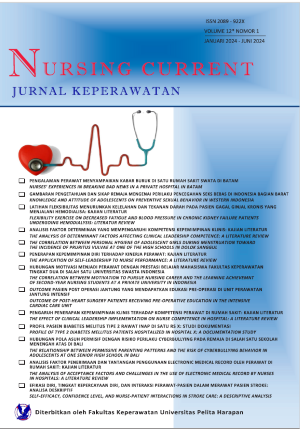THE CORRELATION BETWEEN PERSONAL HYGIENE OF ADOLESCENT GIRLS DURING MENSTRUATION TOWARD THE INCIDENCE OF PRURITUS VULVAE AT ONE OF THE HIGH SCHOOLS IN DOLOK SANGGUL
DOI:
https://doi.org/10.19166/nc.v12i1.8030Keywords:
hygiene, menstruation, pruritus vulvaeAbstract
Pruritus vulvae is an itching sensation in the female genitalia area during menstruation. As many as 5.2 million Indonesian adolescent girls often complain of pruritus vulvae after menstruation due to poor personal hygiene behavior. According to the results of an initial survey of 25 students at one of the high schools in Dolok Sanggul, all students experienced itching in the female genital area during menstruation. The purpose of this study is to investigate whether menstrual hygiene practices and the incidence of pruritus vulvae are related in adolescent girls at one of the high schools in Dolok Sanggul. This study used an analytic quantitative method with a cross-sectional design. The sample for this study was 41 female students using the accidental sampling technique. The research instrument used a questionnaire on the relationship between personal hygiene behavior and the incidence of pruritus vulvae. This research was conducted in February-April 2023. The results of this study showed that 63.4% of class XII students had sufficient personal hygiene behavior during menstruation, and 82.9% of respondents did not experience pruritus vulvae. In this study, personal hygiene behavior towards pruritus vulvae had no relationship, as evidenced by the results of the Chi-square test, p-value = 0.629 (p< 0.05). It is hoped that further research can be conducted by adding research variables and the number of respondents.
References
Alfi, N. R. (2022). Gambaran perilaku personal hygiene pada remaja saat menstruasi di masa new normal di kota Pekanbaru. Jurnal Kesehatan Ilmiah Indonesia, 7(2), 61-72. https://doi.org/http://dx.doi.org/10.51933/health.v7i2.824
Ashari, Z. (2019). Gambaran tingkat pengetahuan personal hygiene tentang menstruasi pada siswi SMP. Jurnal Penelitian Keperawatan Medik, 1(2), 8-15. https://doi.org/10.36656/jpkm.v1i2.78
Bone, K., Tahun, B., Hako, S., Kadir, L., & Ahmad, Z. F. (2022). Perilaku personal hygiene remaja putri saat menstruasi di SMKN 1 bulango selatan. Madu: Jurnal Kesehatan, 11(1), 34-45. https://doi.org/10.31314/mjk.11.1.34-45.2022
Firdaus, H., & Astutik, E. (2019). Gambaran pengetahuan sikap dan perilaku personal hygiene organ genitalia eksterna siswi SMP di kabupaten banyuwangi tahun 2017. Journal of Public Health Research and Community Health Development, 2(1), 52. https://doi.org/10.20473/jphrecode.v2i1.16252
Hanifah, N. N. (2022). Gambaran tingkat pengetahuan remaja putri tentang vulva hygiene di pondok pesantren budi utomo surakarta. Jurnal Ilmiah Kesehatan Masyarakat, 1(4), 679-686. https://doi.org/10.55123/sehatmas.v1i4.974
Harahap, Y. W. (2021). Perilaku personal hygiene remaja putri saat menstruasi di MTS swadaya Padang sidimpuan. Jurnal Kesehatan Ilmiah Indonesia (Indonesian Health Scientific Journal), 6(1), 134. https://doi.org/10.51933/health.v6i1.435
Hilmiati, & Saparwati, M. (2016). Hubungan tingkat stres dengan lama menstruasi pada mahasiswi. Jurnal Keperawatan Jiwa, 4(2). https://doi.org/https://doi.org/10.26714/jkj
Hubaedah, A. (2019). Hubungan pengetahuan dan perilaku vulva hygiene saat menstruasi dengan kejadian pruritus vulvae pada remaja putri kelas vii di SMP Negeri 1 Sepulu Bangkalan. Embrio, 11(1), 30-40. https://doi.org/10.36456/embrio.vol11.no1.a1696
Khatib, A., Adnani, S. S., & Sahputra, R. E. (2019). Hubungan pengetahuan, sikap, dan perilaku personal hygiene dengan gejala vaginitis pada siswi SMPN 1 kota Padang dan SMPN 23 Padang. Jurnal Kesehatan Andalas, 8(1), 19. https://doi.org/10.25077/jka.v8i1.966
Laili, U. (2019). Pemakaian pembalut saat menstruasi dengan kejadian pruritus vulva. Embrio, 11(2), 64-71. https://doi.org/10.36456/embrio.vol11.no2.a2033
Mahfoudh, S. S., Bellalouna, M., & Horchani, L. (2018). Solving CSS-sprite packing problem Using a transformation to the probabilistic non-oriented bin packing problem. Lecture Notes in Computer Science, 10861, 561-573. https://doi.org/10.1007/978-3-319-93701-4_44
Pandelaki, L. G. E. K., Rompas, S., & Bidjuni, H. (2020). Hubungan personal hygiene saat menstruasi dengan kejadian pruritus vulvae pada remaja di sma negeri 7 Manado. Jurnal Keperawatan, 8(1), 68. https://doi.org/10.35790/jkp.v8i1.28413
Parsapure, R., Rahimiforushani, A., Majlessi, F., Montazeri, A., Sadeghi, R., & Garmarudi, G. (2016). Impact of health-promoting educational intervention on lifestyle (nutrition behaviours, physical activity and mental health) related to vaginal health among reproductive-aged women with vaginitis. Iranian Red Crescent Medical Journal, 18(10), e37698. https://doi.org/10.5812/ircmj.37698
Raef, H. S., & Elmariah, S. B. (2021). Vulvar pruritus: A review of clinical associations, pathophysiology and therapeutic management. Frontiers in Medicine, 8. https://doi.org/10.3389/fmed.2021.649402
Swantari, K., Suyasa, G. P. D., & Parwati, W. M. (2022). Hubungan pengetahuan dan perilaku vulva hygiene saat menstruasi dengan kaparahan pruritus vulvae. Jurnal Ilmu Kesehatan MAKIA, 12(2), 160-167. https://doi.org/10.37413/jmakia.v12i2.217
TB, D. R. Y., Nuzul, R., & Nunandar, A. (2020). Pemanfaatan internet sebagai media informasi kesehatan reproduksi di SMK N 1 Darul Kamal Aceh Besar. Jurnal Pengabdian Masyarakat INOTEC UUI, 2(1), 14-20. https://doi.org/10.30656/jpmwp
WHO. (2018). Adolescent health in the South-East Asia Region. https://www.who.int/southeastasia/health-topics/adolescent-health
WHO. (2022). Reproductive health in the South-East Asia Region. https://www.who.int/southeastasia/health-topics/reproductive-health
Downloads
Additional Files
Published
How to Cite
Issue
Section
License
Copyright (c) 2024 Joice Cathryne

This work is licensed under a Creative Commons Attribution-ShareAlike 4.0 International License.
Authors who publish with this journal agree to the following terms:
1) Authors retain copyright and grant the journal right of first publication with the work simultaneously licensed under a Creative Commons Attribution License (CC-BY-SA 4.0) that allows others to share the work with an acknowledgement of the work's authorship and initial publication in this journal.
2) Authors are able to enter into separate, additional contractual arrangements for the non-exclusive distribution of the journal's published version of the work (e.g., post it to an institutional repository or publish it in a book), with an acknowledgement of its initial publication in this journal.
3) Authors are permitted and encouraged to post their work online (e.g., in institutional repositories or on their website). The final published PDF should be used and bibliographic details that credit the publication in this journal should be included.

This work is licensed under a Creative Commons Attribution-ShareAlike 4.0 International License.






